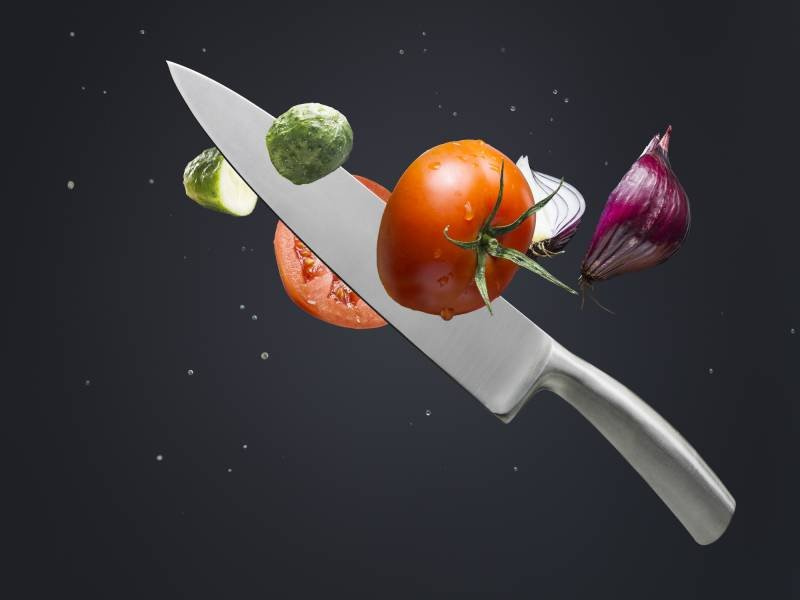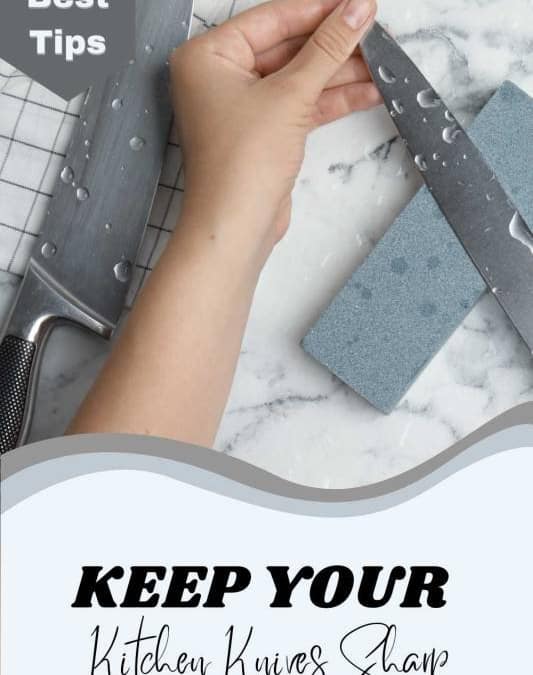Vegan Globetrotter is supported by our audience. When you purchase through one of our links, we may earn a small affiliate commission. As an Amazon Associate I earn from qualifying purchases. Your cost is not affected.
==================
Keep Kitchen Knives Sharp During and Between Uses
Hey there! Chefs and home cooks struggle to sharpen kitchen knives. We’ve all been there, but there’s good news – ways to keep kitchen knives sharp don’t have to be a chore! Maintaining sharp knives between uses makes meal prep easier.

ID 46682130 © Piotr Mazur | Dreamstime.com
So, this article will give you tips and tricks for keeping your kitchen knives sharp. Chefs and home cooks can maintain their knives using these approaches. Instead of battling dull blades, they might enjoy cooking. So, let’s see and discover how to keep your knives sharp during and between uses.
Ways to Keep Kitchen Knives Sharp

ID 85606920 © Bogdan Hoda | Dreamstime.com
Sharp kitchen knives are crucial in any kitchen. But keeping them pointy can be challenging. Dull knives not only make cooking more difficult, but they can also be dangerous. Luckily, there have been various easy ways to sharpen kitchen knives for years.
1. Honing Steel
Let’s talk about honing steel! It’s a standard kitchen tool, but it needs more clarity around what it does. Here’s the scoop – honing steel is not a knife sharpener. It’s more like a realignment tool that helps straighten the edge of your knife blade. And the good news is, using it is pretty simple!

ID 32410104 © Aaron Priestley-wright | Dreamstime.com
First, hold the honing steel in your non-dominant hand and the knife in your dominant hand. Elevate the honing steel above its handle, keeping your fingers away from the blade. Hold the knife at a 20-degree angle first. Then slide it from the heel to the blade’s tip across the rod. Repeat on the bottom of the rod on the other side of the knife blade. Before you use your kitchen knife, it’s best to do six to eight repetitions. Practice makes it easier and faster. Thus, don’t be afraid to try honing – it’s a simple way to keep kitchen knives sharp and in excellent condition!
2. Electric Knife Sharpeners
You can use an electric sharpener! It’s as simple as using a whetstone, but with the bonus of speed. These valuable tools have slots for honing and sharpening. Dragging your kitchen knives through the spaces is the best way to do the job.
Also, the spring-loaded grinding wheels polish kitchen knife edges at the right angle. But read and follow the directions, or you may damage the blade.

ID 233162958 © Iurii Korolev | Dreamstime.com
Avoid twisting the kitchen knife, pressing too hard, and hesitating during the stroke. These mistakes might cause over-sharpening or uneven edges. Hence, an electric sharpener can maintain kitchen knives sharp with some care!
3. Whetstone
All you need is a whetstone! It’s a small block of stone with a good and rough side. First, place a damp cloth on a flat surface and put the whetstone on top to ensure the stone stays put. Then, wet the stone with a bit of water to reduce friction and prepare to sharpen it. Place the knife on the rough side of the stone, ensuring it’s at a 15-20 degree angle and the tip points away from you.

ID 77950709 © Alexkm472 | Dreamstime.com
It’s as simple as that! Keep your kitchen knives sharp with a bit of practice. Grab your whetstone and get sharpening – your knives (and your taste buds) will thank you!
4. Bottom of Ceramic Mug or Cup

ID 182319861 © GCapture | Dreamstime.com
Need a fancy knife sharpener at home? No problem. You can still get razor-sharp kitchen knives using everyday kitchen items! Grab a ceramic mug, plate, or cup and turn it upside down. Slide your kitchen knife blade across the rough dish bottom on both sides at a constant 20 degrees. It might take a little longer than a dedicated sharpener, but you’ll still get great results. And if you have a honing rod handy, you can give your kitchen knife an extra polish by repeating the process a few times. With some elbow grease, you’ll have a sharp knife to handle any kitchen task fast. So next time your blades start to dull, grab a ceramic dish and sharpen!
5. Wash Kitchen Knives Using Your Hands
There are better ways to clean knives besides using the dishwasher. Keep this in mind if you value the sharpness of your kitchen knives. The heat, water, and detergent can dull them down fast! Instead, give your kitchen knives a little care by washing them by hand. It might take a bit longer, but keeping those knives sharp and in excellent condition is worth it.

ID 117078498 © Scullery | Dreamstime.com
Plus, you’ll have a chance to give each kitchen knife extra attention and care while cleaning them. Now you know! Next time you clean up after a meal, skip the dishwasher and give your blades a gentle hand wash instead!
6. Store Your Kitchen Knife in a Proper Place
Refrain from mixing your fine knives with other kitchen tools. Kitchen knives need proper storage to stay sharp, safe and protected. You can set aside a whole drawer for your blades, but they may get damaged by bumping into each other. A wooden or knife block is an excellent option for storing a complete set of knives and a honing rod.

ID 125743808 © Ozgur Coskun | Dreamstime.com
Yet, our top choice is a magnetic knife rack. It preserves your kitchen knives and looks good on the wall. Plus, it keeps them out of reach of curious children.
7. Choose the Right Chopping Board
Did you know that the cutting board you use can affect how sharp and blunt your knives are? Let me tell you all about it! If you want to keep kitchen knives pointy, wooden chopping boards are the way to go. The softwood doesn’t damage the knife edge, and it’s also a beautiful natural option. Plastic cutting boards are also great for keeping knives’ edges sharp. You can also put them in the dishwasher to clean them.

ID 82572807 © Andrii Kucher | Dreamstime.com
Even so, cutting on glass or ceramic plates dulls knives fast. Please use softer cutting surfaces to keep your kitchen knives sharp!
8. Call Kitchen Knife Sharpening Services

ID 198747496 © Grafvision | Dreamstime.com
Understandably, some individuals hate sharpening kitchen knives. That’s why some folks have started using services specializing in sharpening kitchen knives. That appears wasteful, yet it frees up time for more important duties. A professional sharpening service can keep kitchen knives sharp and ready to use. Then go ahead and take advantage of this convenient option!
Sharpening VS. Honing: What is the difference in keeping your kitchen knives sharp?
In some cases, people will confuse sharpening with honing. Honing adjusts the knife blade without removing metal. This is crucial because if you use your knives a lot, the edge can get bent out of shape. Honing straightens the blade and ensures it stays in position.

ID 192574129 © Selma Arslan | Dreamstime.com | ID 8348248 © Africa Rising Agency | Dreamstime.com
But sharpening involves removing bits of metal from the blade to create a new edge. Use caution because this procedure can dull a knife’s edge. Still, you can keep the edge on your kitchen knife by honing it more often.
Here is a quick video about kitchen knives.
Things That Will Ruin Your Kitchen Knives
1. Don’t Oversharpen Your Knives

ID 192574129 © Selma Arslan | Dreamstime.com
Oversharpening kitchen knives might limit their lifespan. Use a sharpening guide to help you get the job done right.
2. Use a Soft Sponge or Cloth to Clean Your Knife Blade

ID 214655178 © Svetlana Kolpakova | Dreamstime.com
Avoid using metal scrubbers or rough materials that could cause big problems. Hot water and a gentle touch should keep your kitchen knives clean.
3. Only Use Your Kitchen Knives for Food Prep

ID 236444810 © Oleksandr Latkun | Dreamstime.com
4. Don’t Let Knives Sit Wet on the Sink

ID 97799825 © Anuruk Charoenamornrat | Dreamstime.com
Avoid soaking kitchen knives in water, as the dishwasher may ruin their handles. Wash them by hand and dry them immediately to prevent rust and corrosion.
5. Don’t Scrape Your Knife Sideways on the Cutting Board

Photo 101181365 © Rachelwebdesign | Dreamstime.com
Kitchen knives cut back and forth, not sideways. The scraping damages the blade over time. If you can’t resist, try to be gentle and avoid using too much force.
6. Stick to Wood or Plastic Cutting Boards

ID 130669509 © Natalia Karjalainen | Dreamstime.com
Stone, marble, and glass surfaces may look pretty, but they must be more knife-friendly. They’ll dull your blade faster than almost anything else. Bamboo and plastic are gentle on your knives and budget-friendly.
7. Store the Knives with Other Metal Tools in a Drawer

ID 16564647 © Sue Harper | Dreamstime.com
This big mistake can dull or chip your kitchen knives over time. Keep them safe with a knife block, in-drawer wooden knife rack, plastic cases, or a magnetic knife rack.
Always Keep Your Kitchen Knives Sharp
Lastly, to keep kitchen knives sharp, it is necessary to maintain a safe and efficient kitchen. This article’s recommendations ensure your blades last for years. Keep your blades sharp, secure, and clean by working on a good cutting surface. You can use sharp, trustworthy kitchen knives every time you cook with a little effort. So go ahead and sharpen those knives, and get ready to take your cutting skills to the next level!
Want to Read More?
Gluten and Tofu as Meat Substitutes
FAQs
Can I sharpen my kitchen knives with an honing steel?
Can I sharpen a kitchen knife with teeth?
How sharp can a knife be?





Don't miss out
when new recipes and information are added!
Join our newsletter for free recipes,
healthy living inspiration, and special offers
You have Successfully Subscribed!